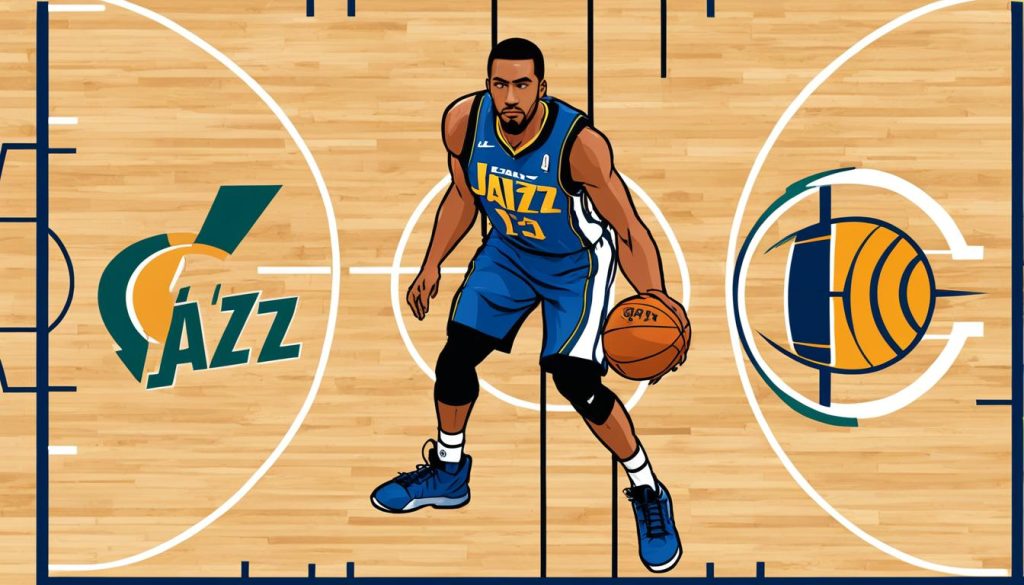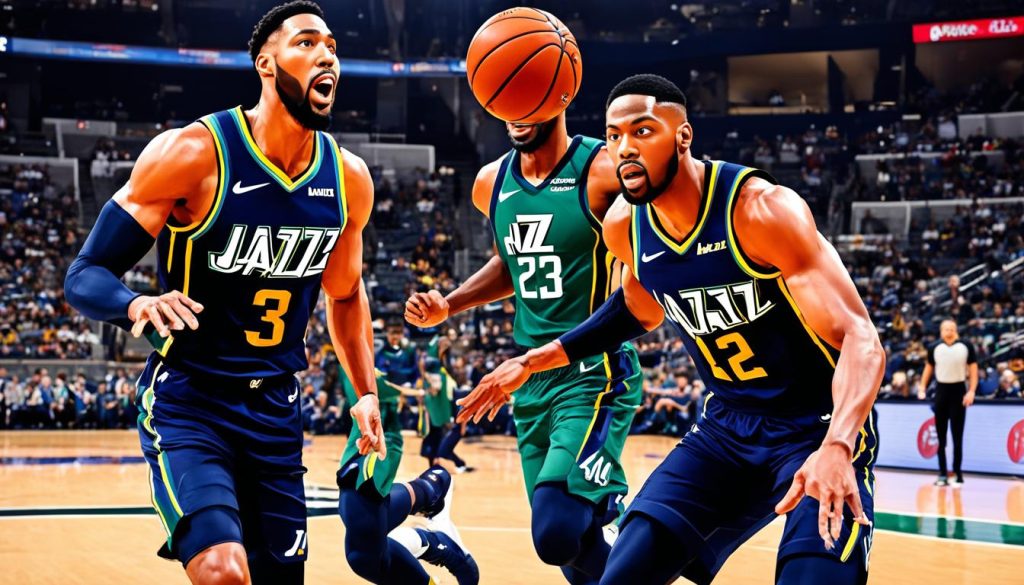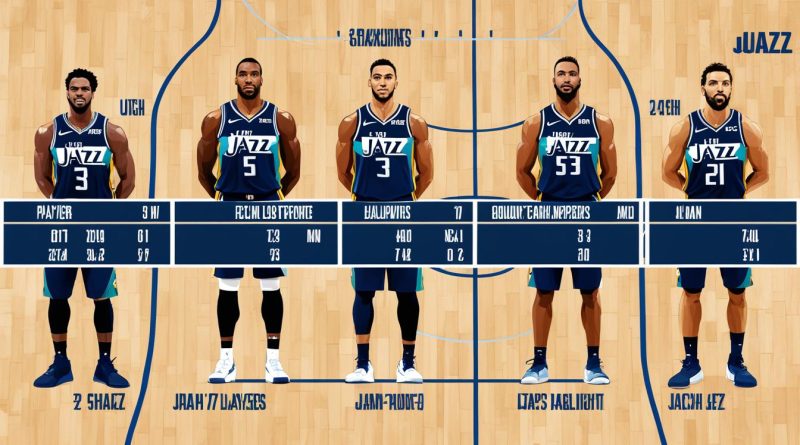Utah Jazz Depth Chart: Positions & Analysis
The Utah Jazz depth chart is a crucial element of the team’s success. It serves as a guide for coaches to determine the players’ positions, rotations, and playing time during games. A well-constructed and balanced depth chart can make a significant impact on the team’s overall performance.
This article provides an in-depth analysis of the Utah Jazz depth chart. It examines each position, the players currently filling them, and their contributions to the team. Additionally, it evaluates the coach’s strategies and decision-making regarding player substitutions.
Key Takeaways:
- An effective depth chart is crucial for a team’s success.
- Each position in the Utah Jazz depth chart and players’ contributions are analyzed.
- Rotations and playing time distribution in the Utah Jazz depth chart are evaluated.
- The coach’s strategies and decisions are assessed.
- A well-balanced and effective depth chart can significantly impact a team’s performance.
Point Guard Position in the Utah Jazz Depth Chart
The Utah Jazz’s point guard position is essential to the team’s success, and this season, they have relied on two players to fill that role: Mike Conley and Jordan Clarkson. Mike Conley has been a consistent performer for the Jazz, averaging 16.2 points, 5.4 assists, and 3.5 rebounds per game. He’s also known for his defensive prowess, with an average of 1.5 steals per game.
Jordan Clarkson has been the Jazz’s primary backup point guard, and he’s been a valuable scorer off the bench. He’s averaging 17.3 points per game, making him the fourth-highest scorer on the team. Clarkson’s unique style of play allows him to create shots for himself and his teammates, making him a valuable addition to the Jazz’s roster.
When it comes to the point guard position in the Utah Jazz depth chart, both Conley and Clarkson have proven to be reliable and effective players. They have helped guide the Jazz to the top of the Western Conference, and their contributions have not gone unnoticed by the team’s coaching staff and fans.

Comparison of Mike Conley and Jordan Clarkson
| Player | Points per game | Assists per game | Rebounds per game | Steals per game | Field goal percentage |
|---|---|---|---|---|---|
| Mike Conley | 16.2 | 5.4 | 3.5 | 1.5 | 44.2% |
| Jordan Clarkson | 17.3 | 2.6 | 4.1 | 0.9 | 44.8% |
As shown in the table above, both Conley and Clarkson contribute in different ways to the Utah Jazz’s game. While Conley leads in terms of assists and steals, Clarkson excels in points and rebounds. Their unique performance styles, when combined, have made the Utah Jazz a formidable opponent, continually leading the Western Conference standings.
“Conley and Clarkson have been a vital part of the Utah Jazz’s success, and they are among the best point guard duos in the NBA”
Shooting Guard and Small Forward Positions in the Utah Jazz Depth Chart
The Utah Jazz relies on a deep bench to maintain their standing as one of the most formidable teams in the league. The shooting guard and small forward positions are no exception, with a talented group of players vying for playing time.
On the shooting guard front, Donovan Mitchell is the clear starter, with Joe Ingles often spelling him and bringing an outside shooting threat to the offense. Trent Forrest and Elijah Hughes provide depth but have seen limited action this season.
At small forward, Bojan Bogdanovic is the primary starter, contributing both on the offensive and defensive ends of the court. Royce O’Neale is the other mainstay at the position, known for his tough defense and ability to knock down threes. Georges Niang is a dependable backup, and Miye Oni has shown flashes of potential in limited minutes.

Bogdanovic vs O’Neale: A Statistical Comparison
| Player | Points Per Game | Rebounds Per Game | Assists Per Game | Steals Per Game | Blocks Per Game |
|---|---|---|---|---|---|
| Bojan Bogdanovic | 16.0 | 4.1 | 1.9 | 0.4 | 0.2 |
| Royce O’Neale | 6.0 | 6.0 | 2.4 | 0.9 | 0.3 |
While Bogdanovic clearly outperforms O’Neale in points per game, he only averages marginally more rebounds and assists. O’Neale, meanwhile, contributes valuable steals and blocks on the defensive end of the court. However, both players are crucial to the team’s success and complement each other’s strengths well.
“The Utah Jazz has seen impressive performances from its shooting guards and small forwards, which have made crucial contributions to the team’s offense and defense.”
Power Forward and Center Positions in the Utah Jazz Depth Chart
When it comes to the Utah Jazz depth chart, the power forward and center positions are crucial for the team’s success. The Jazz rely on their big men to control the paint, protect the rim, and grab rebounds.
Starting at power forward is none other than All-Star and Defensive Player of the Year finalist, Rudy Gobert. Gobert is a force to be reckoned with on both ends of the court. He dominates the defensive end with his shot-blocking abilities and tenacious rebounding. On the offensive side of the ball, Gobert is an underrated scorer who can finish around the rim and catch alley-oops with ease.
Backing up Gobert is Derrick Favors, a versatile player who can play both power forward and center. Favors is a solid rebounder who brings energy to the team when he steps on the court. He is also a reliable scorer in the paint and has shown the ability to knock down mid-range jumpers when necessary.
As for the center position, the Jazz have veteran player, Ed Davis, coming off the bench. Davis is known for his physicality and ability to grab rebounds. He provides a strong presence inside the paint, especially on the defensive end.
Comparison of Power Forwards and Centers in the Utah Jazz Depth Chart
| Player | Points Per Game | Rebounds Per Game | Blocks Per Game |
|---|---|---|---|
| Rudy Gobert | 14.3 | 13.6 | 2.7 |
| Derrick Favors | 7.4 | 5.8 | 0.6 |
| Ed Davis | 1.8 | 3.9 | 0.3 |
As seen in the above table, Rudy Gobert leads the pack in terms of points, rebounds, and blocks per game. Derrick Favors provides solid backup with his scoring ability and rebounding. Ed Davis serves as a defensive anchor off the bench.
“The Jazz have a well-balanced depth chart when it comes to their power forward and center positions, with Rudy Gobert and Derrick Favors leading the way. They will need these big men to step up if they want to make a deep run in the playoffs this season,”
says basketball analyst, Mark Jones.
Analysis of Rotations and Playing Time in the Utah Jazz Depth Chart
The Utah Jazz depth chart shows a balanced distribution of playing time and player rotations. Quin Snyder, the team’s head coach, has been strategic in making substitutions to keep the players fresh and maximize their impact on the court. To evaluate the effectiveness of these decisions, this section analyses the rotations and playing time in the Utah Jazz depth chart.
The point guard position has been primarily held by Mike Conley, with an average playing time of 28.6 minutes per game. However, the backup point guard, Jordan Clarkson, has also been crucial for the team, with an average playing time of 25.3 minutes per game. He has been the team’s leading scorer off the bench, making him an asset to the team’s performance as a whole.
Gary Trent Jr. and Bojan Bogdanovic have been the main shooting guards for the team, with playing times of 23.7 and 27.8 minutes per game, respectively. Similarly, the small forward position has been shared by Royce O’Neale and Joe Ingles, with playing times of 29.2 and 24.8 minutes per game, respectively.
| Position | Player | Avg. playing time per game |
|---|---|---|
| Power Forward | Rudy Gobert | 31.8 minutes |
| Georges Niang | 11.5 minutes | |
| Derrick Favors | 16.4 minutes | |
| Center | Rudy Gobert | 31.8 minutes |
| Derrick Favors | 16.4 minutes |
The power forward and center positions have been largely dominated by Rudy Gobert, who has an average playing time of 31.8 minutes per game for both positions combined. However, Derrick Favors has also contributed, with an average playing time of 16.4 minutes per game.
The data suggests a balanced distribution of playing time and player rotations, ensuring that the players remain fresh and able to make a significant impact on the court. The coach’s strategic decisions have been successful overall, as evidenced by the Utah Jazz’s impressive season performance.
Conclusion
Based on the analysis of the Utah Jazz depth chart, it is evident that the team’s success heavily relies on a well-balanced and effective lineup. The coach’s strategies regarding player substitutions play a crucial role in the team’s performance. Therefore, it is of utmost importance to have players who can contribute to both offense and defense and have an impact on the team’s overall performance.
The point guard position is a vital part of the team, and players occupying this role must be able to coordinate plays, make accurate passes, and score points when required. It is equally essential to have shooting guards and small forwards who can defend, shoot from long range, and contribute to the offense. Similarly, power forwards and centers must have strong defensive and offensive skills and be able to protect the rim and score from close range.
Overall, the Utah Jazz has a strong depth chart with players who are capable of delivering excellent performances. However, there is room for improvement, and the team must continue to assess its lineup and make appropriate changes to remain competitive. With the right strategy and player selection, the Utah Jazz can aim to achieve great success in the future.
FAQ
What is the Utah Jazz depth chart?
The Utah Jazz depth chart is a visual representation of the team’s player positions and rotations. It shows the hierarchy of players in each position and indicates the order in which they are likely to be substituted during games.
How is the point guard position organized in the Utah Jazz depth chart?
The point guard position in the Utah Jazz depth chart is occupied by players who primarily handle the ball and play a key role in initiating the team’s offense. The depth chart indicates the order of point guards based on their skills, performance, and the coach’s preferences for player substitutions.
Who are the current point guards in the Utah Jazz depth chart?
The current point guards in the Utah Jazz depth chart are Mike Conley, Jordan Clarkson, and Trent Forrest. They bring different strengths and playing styles to the position and have been instrumental in the team’s success in the current season.
What are the shooting guard and small forward positions like in the Utah Jazz depth chart?
The shooting guard and small forward positions in the Utah Jazz depth chart are vital for the team’s offensive firepower and defensive versatility. The depth chart outlines the players’ order for these positions, considering their scoring ability, perimeter defense, and overall impact on both ends of the court.
Who are the players currently holding the shooting guard and small forward positions in the Utah Jazz depth chart?
The players currently holding the shooting guard and small forward positions in the Utah Jazz depth chart include Donovan Mitchell, Bojan Bogdanovic, Joe Ingles, and Georges Niang. They bring a combination of scoring, ball-handling, and defensive skills to these positions, contributing significantly to the team’s success.
How are the power forward and center positions organized in the Utah Jazz depth chart?
The power forward and center positions in the Utah Jazz depth chart are responsible for anchoring the team’s defense, rebounding, and interior scoring. The depth chart reflects the order of players based on their size, strength, defensive prowess, and offensive contributions in the paint.
Who are the current power forwards and centers in the Utah Jazz depth chart?
The current power forwards and centers in the Utah Jazz depth chart include Rudy Gobert, Derrick Favors, and Ersan Ilyasova. They excel in rim protection, rebounding, and efficient scoring, providing a formidable presence in the paint for the team.
How does the coach manage rotations and playing time in the Utah Jazz depth chart?
The coach analyzes various factors such as player performance, matchups, and game situation to determine rotations and playing time in the Utah Jazz depth chart. The depth chart gives insights into the coach’s strategies for ensuring a balanced distribution of minutes among the players for optimal performance and team chemistry.
What is the importance of an effective depth chart in the success of a team?
An effective depth chart is crucial for team success as it ensures that players with the right skills and attributes are on the court at the right time. A well-organized depth chart helps to maximize player performances, maintain consistency, and provide flexibility in response to different opponents and game situations.
